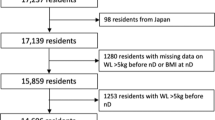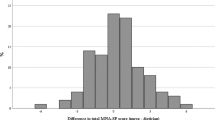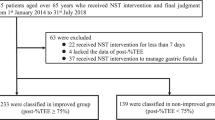Abstract
Introduction
Standardised nutritional screening methods improve the rate of recognising older patients with undernutrition, which is strongly encouraged in hospitals and residential settings. Therefore, our study compared the rates of identifying undernutrition before and after introducing the Mini Nutritional Assessment (MNA®) in a community hospital.
Methods
This was a single-centre, retrospective, observational before–after study. Participants were subjects aged 65 years or older, admitted to a community hospital from May 2018 to December 2020. The nursing assessment at admission included the MNA® from January 2020. The prevalence of undernutrition gathered by nursing diagnoses from 2018 to 2019 was compared with data obtained using the MNA® in 2020. Then, a confirmatory analysis was conducted to compare the prevalence of undernutrition in 2020 when both nursing diagnoses and the MNA® were used.
Results
We analysed data of approximately 316 patients (238 before and 78 after introducing the MNA®). Overall, results showed that 47.1% (n = 149) of the patients were undernourished. As observed, the prevalence of undernutrition was 38.6% (n = 92) in 2018–2019 and 73.1% (n = 57) in 2020 (p < 0.001). In 2020, however, 38.5% of patients (n = 30) were identified as undernourished using the MNA® but not using nursing diagnoses. Therefore, the correlation between these two methods was poor (Pearson’s correlation 0.169, p = 0.14).
Conclusion
Identifying elderly patients with undernutrition significantly increased after introducing the MNA®. Undernutrition is a common condition that should be systematically screened using a validated tool to activate personalised nutritional interventions promptly.
This is a preview of subscription content, access via your institution
Access options
Subscribe to this journal
Receive 12 print issues and online access
$259.00 per year
only $21.58 per issue
Buy this article
- Purchase on SpringerLink
- Instant access to full article PDF
Prices may be subject to local taxes which are calculated during checkout

Similar content being viewed by others
Data availability
The data that support the findings of this study are available from the corresponding author, BG, upon reasonable request.
References
Cereda E, Pedrolli C, Klersy C, Bonardi C, Quarleri L, Cappello S, et al. Nutritional status in older persons according to healthcare setting: a systematic review and meta-analysis of prevalence data using MNA®. Clin Nutr. 2016;35:1282–90.
Törmä J, Winblad U, Cederholm T, Saletti A. Does undernutrition still prevail among nursing home residents? Clin Nutr. 2013;32:562–8.
Cederholm T, Barazzoni R, Austin P, Ballmer P, Biolo G, Bischoff SC, et al. ESPEN guidelines on definitions and terminology of clinical nutrition. Clin Nutr. 2017;36:49–64.
Söderström L, Rosenblad A, Thors Adolfsson E, Bergkvist L. Malnutrition is associated with increased mortality in older adults regardless of the cause of death. Br J Nutr. 2017;117:532–40.
Naffouje SA, De La Cruz K, Berard D, Guy S, Salti GI. Knowledge, attitudes and practice of surgeons regarding nutritional support in CRS and HIPEC patients: are we missing something? Eur J Cancer Care. 2019;28:12930.
Harkin N, Johnston E, Mathews T, Guo Y, Schwartzbard A, Berger J, et al. Physicians’ dietary knowledge, attitudes and counseling practices: the experience of a single health care centre at changing the landscape for dietary education. Am J Lifestyle Med. 2018;13:292–300.
O Connell MB, Jensen PS, Andersen SL, Fernbrant C, Nørholm V, Petersen HV. Stuck in tradition-a qualitative study on barriers for implementation of evidence-based nutritional care perceived by nursing staff. J Clin Nurs. 2018;27:705–14.
Halvorsen K, Eide HK, Sortland K, Almendingen K. Documentation and communication of nutritional care for elderly hospitalized patients: perspectives of nurses and undergraduate nurses in hospitals and nursing homes. BMC Nurs. 2016;15:1–10.
Vearing R, Casey S, Zaremba C, Bowden S, Ferguson A, Goodisson C, et al. Evaluation of the impact of a post-hospital discharge Transitional Aged Care Service on frailty, malnutrition and functional ability. Nutr Diet. 2019;76:472–9.
White JV, Stotts N, Jones SW, Granieri E. Managing postacute malnutrition (undernutrition) risk. J Parenter Enter Nutr. 2013;37:816–23.
Gasperini B, Pelusi G, Frascati A, Sarti D, Dolcini F, Espinosa E, et al. Predictors of adverse outcomes using a multidimensional nursing assessment in an Italian community hospital. PLoS ONE. 2021;16:e0249630.
Müller-Staub M, Lavin MA, Needham I, van Achterberg T. Nursing diagnoses, interventions and outcomes - application and impact on nursing practice: systematic review. J Adv Nurs. 2006;56:514–31.
Conley D, Schultz AA, Selvin R. The challenge of predicting patients at risk for falling development of the Conley Scale. Medsurg Nurs. 1999;8:348–54.
Norton D, McLaren R, Exton-Smith AN. An investigation of geriatric nursing problems in a hospital. London: The National Corporation for the Care of Old People; 1962. p. 238.
Poledníková Ľ, Slamková A, Solgajová A, Zrubcová D. Malnutrition in older people in clinical nursing diagnosis. Kontakt. 2019;21:337–43.
Vellas B, Guigoz Y, Garry PJ, Nourhashemi F, Bennahum D, Lauque S, et al. The mini nutritional assessment (MNA®) and its use in grading the nutritional state of elderly patients. Nutrition. 1999;15:116–22.
von Elm E, Altman DG, Egger M, Pocock SJ, Gøtzsche PC, Vandenbroucke JP, STROBE Initiative. The strengthening the reporting of observational studies in epidemiology (STROBE) statement: guidelines for reporting observational studies. J Clin Epidemiol. 2008;61:344–9.
Guigoz Y, Vellas B. Nutritional assessment in older adults: MNA® 25 years of a screening tool and a reference standard for care and research; what next? J Nutr Health Aging. 2021;25:528–83.
Morley JE. Anorexia of ageing: a key component in the pathogenesis of both sarcopenia and cachexia. J Cach Sarc Muscle. 2017;8:523–6.
Field LB, Hand RK. Differentiating malnutrition screening and assessment: a nutrition care process perspective. J Acad Nutr Diet. 2015;115:824–8.
Meehan A, Partridge J, Jonnalagadda SS. Clinical and economic value of nutrition in healthcare: a nurse’s perspective. Nutr Clin Pr. 2019;34:832–8.
Crowley J, Ball L, McGill AT, Buetow S, Arroll B, Leveritt M, et al. General practitioners’ views on providing nutrition care to patients with chronic disease: a focus group study. J Prim Health Care. 2016;8:357–64.
Mogre V, Nsoh JA, Wanaba P, Apala P. Demographic factors, weight management behaviours, receipt of healthcare professional’s counselling and having knowledge in basic anthropometric measurements associated with underassessment of weight status in overweight and obese type 2 diabetes patients. Obes Res Clin Pract. 2016;10:381–9.
NICE. Methods for the development of NICE public health guidance (third edition) (PMG4). 2012. https://www.nice.org.uk/process/pmg4/resources/methods-for-the-development-of-nice-public-health-guidance-third-edition-pdf-2007967445701.
Brunner S, Mayer H, Breidert M, Dietrich M, Müller-Staub M. Developing a nursing diagnosis for the risk for malnutrition: a mixed-method study. Nurs Open. 2021;8:1463–78.
Acknowledgements
We thank the nursing staff of the community hospital of Loreto (Ancona). This research received no specific grant from any funding agency, commercial or not-for-profit sectors.
Author information
Authors and Affiliations
Contributions
BG: Study concept and design, analysis, and interpretation of data, writing the report, conducting the search. GP: Study concept and design, formulating the research question, interpretation of data. AF: Acquisition of data, interpretation of data, writing the report. IC: Acquisition of data, interpretation of data, writing the report. FD: Acquisition of data, interpretation of data. DS: Analysis and interpretation of data, writing the report, extracting, and analysing data, interpreting results, and creating tables and figures. EE: Drafting of the manuscript, critical revision of the manuscript for important intellectual content and provided feedback on the report. EP: Conceived and designed the experiments, analysis and interpretation of data, critical revision of the manuscript for important intellectual content and provided feedback on the report.
Corresponding author
Ethics declarations
Competing interests
The authors declare no competing interests.
Ethical approval
Given this was a retrospective observational study, ethical committee approval was not required. The study was performed in accordance with the Code of Ethics of the World Medical Association for experiments involving humans (Declaration of Helsinki) and research on health databases (Declaration of Taipei). Patients and caregivers gave their consent to use their personal data at their admission to the CH. Patient anonymity was respected during the process of data analysis and results reporting.
Additional information
Publisher’s note Springer Nature remains neutral with regard to jurisdictional claims in published maps and institutional affiliations.
Rights and permissions
About this article
Cite this article
Gasperini, B., Pelusi, G., Frascati, A. et al. Recognising undernutrition in a community hospital: the nursing judgement is insufficient. Eur J Clin Nutr 76, 1611–1614 (2022). https://doi.org/10.1038/s41430-022-01145-y
Received:
Revised:
Accepted:
Published:
Issue date:
DOI: https://doi.org/10.1038/s41430-022-01145-y



